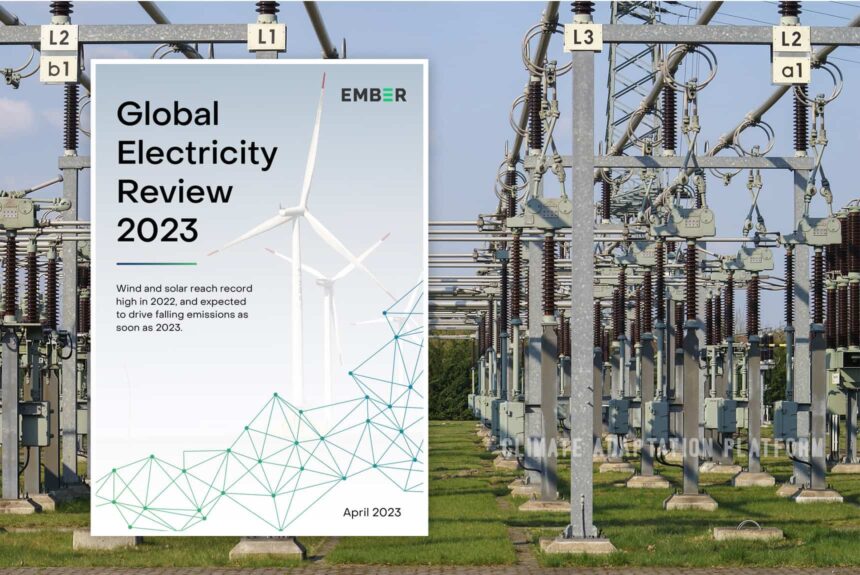The fourth edition of Ember’s Global Electricity Review brings encouraging news.
The report reveals that the world uses fewer fossil fuels than it used to generate electricity. In 2022, solar and wind reached a record 12% share of global energy production.
The report notes that the drop in fossil fuel use and the growth in solar and wind generation means that the carbon emission from the energy sector may have already peaked.
The decarbonisation of the energy sector is underway, with record growth in wind and solar driving down the emission intensity of the energy sector to its lowest level in 2022. However, although seeing the power sector emissions falling year-on-year will be impressive, the report says the world is not there yet and has to put in more effort for this to happen.
China has a significant role in the global growth of renewables. The country has added around 50% of global wind power and 40% of global solar energy, but the country remains the biggest user of coal-generated electricity (McGrath, 2023).
The following are key highlights of the report:
Electricity is at its cleanest. Wind and solar generate 12% of global power.
The carbon intensity of global electricity generation fell to a record low of 436 gCO2/kWh in 2022, the cleanest-ever electricity. This was due to record growth in wind and solar, which reached a 12% share in the global electricity mix, up from 10% in 2021. All clean electricity sources (renewables and nuclear) reached 39% of global electricity, a new record high. Solar generation rose by 24%, making it the fastest-growing electricity source for 18 years; wind generation grew by 17%. The increase in global solar generation in 2022 could have met the annual electricity demand of South Africa, and the rise in wind generation could have powered almost all of the UK. Over sixty countries now generate more than 10% of their electricity from wind and solar. However, other clean electricity sources dropped for the first time since 2011 due to a fall in nuclear output and fewer new nuclear and hydro plants coming online.
Limited coal increase and gas plateaus.
Electricity is cleaner than ever, but we are using more of it. Power sector emissions rose in 2022 (+1.3%), reaching an all-time high. Coal generation increased by 1.1%, in line with average growth in the last decade. The ‘coal power phasedown’ agreed upon at COP26 in 2021 may not have begun in 2022, but the energy crisis didn’t lead to a major increase in coal burning, as many feared. Gas power generation fell marginally (-0.2%) in 2022–for the second time in three years–in the wake of high gas prices globally. Gas-to-coal switching was limited in 2022 because gas was already mostly more expensive than coal in 2021. Only 31 GW of new gas power plants were built in 2022, the lowest in 18 years. But 2022 saw the lowest number of coal plant closures in seven years, as countries look to maintain backup capacity, even as the transition picks up speed.
Power emissions may “peak” in 2022.
Wind and solar are slowing the rise in power sector emissions. The growth alone in wind and solar generation (+557 TWh) met 80% of global electricity demand growth in 2022 (+694 TWh). If all the electricity from wind and solar instead came from fossil generation, power sector emissions would have been 20% higher in 2022.
Clean power growth will likely exceed electricity demand growth in 2023; this would be the first year for this to happen outside of a recession. With the average increase in electricity demand and clean power, we forecast that 2023 will see a slight fall in fossil generation (-47 TWh, -0.3%), with more significant falls in subsequent years as wind and solar grow further. That would mean 2022 hit “peak” emissions. A new era of falling power sector emissions is close.
“The report analyses electricity data from 78 countries representing 93% of global electricity demand and includes estimated changes in the remaining generation. It also dives deeper into the top ten CO2-emitting countries and regions, accounting for over 80% of global CO2 emissions.”
Małgorzata Wiatros-Motyka, Senior Electricity Analyst at Ember, says, “In this decisive decade for the climate, it is the beginning of the end of the fossil age. We are entering the clean power era. The stage is set for wind and solar to achieve a meteoric rise to the top. Clean electricity will reshape the global economy, from transport to industry and beyond. A new era of falling fossil emissions means the coal power phasedown will happen, and the end of gas power growth is now within sight. Change is coming fast. However, it all depends on governments, businesses, and citizens’ actions to put the world on a pathway to clean power by 2040.”
Source:
Global Electricity Review 2023. (2023, April 12). Ember. Retrieved from https://ember-climate.org/insights/research/global-electricity-review-2023/
McGrath, M. (2023, April 13). Climate change: Fossil fuel emissions from electricity set to fall – report. BBC. Retrieved from https://www.bbc.com/news/science-environment-65240094



Leave a Reply